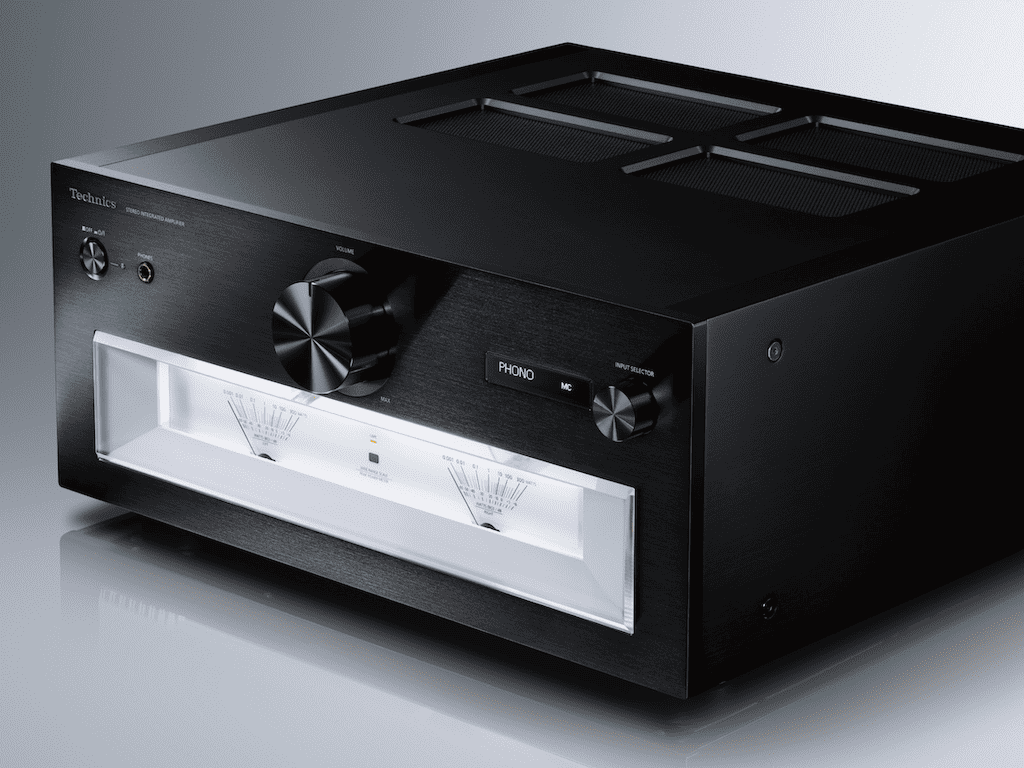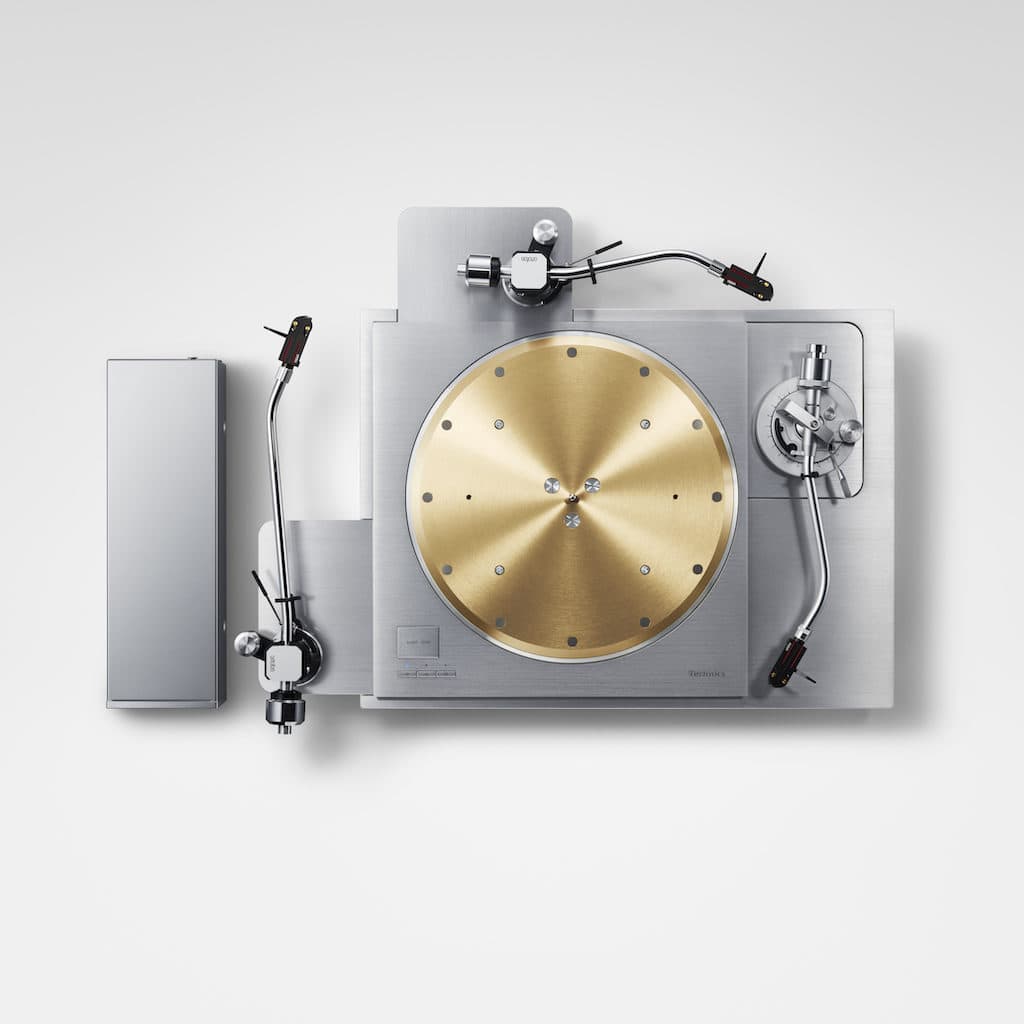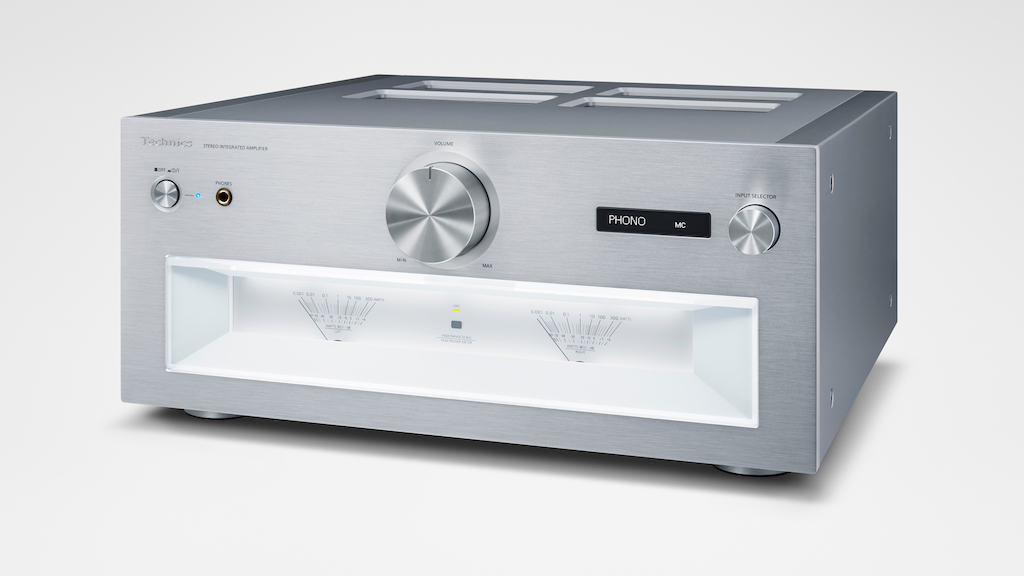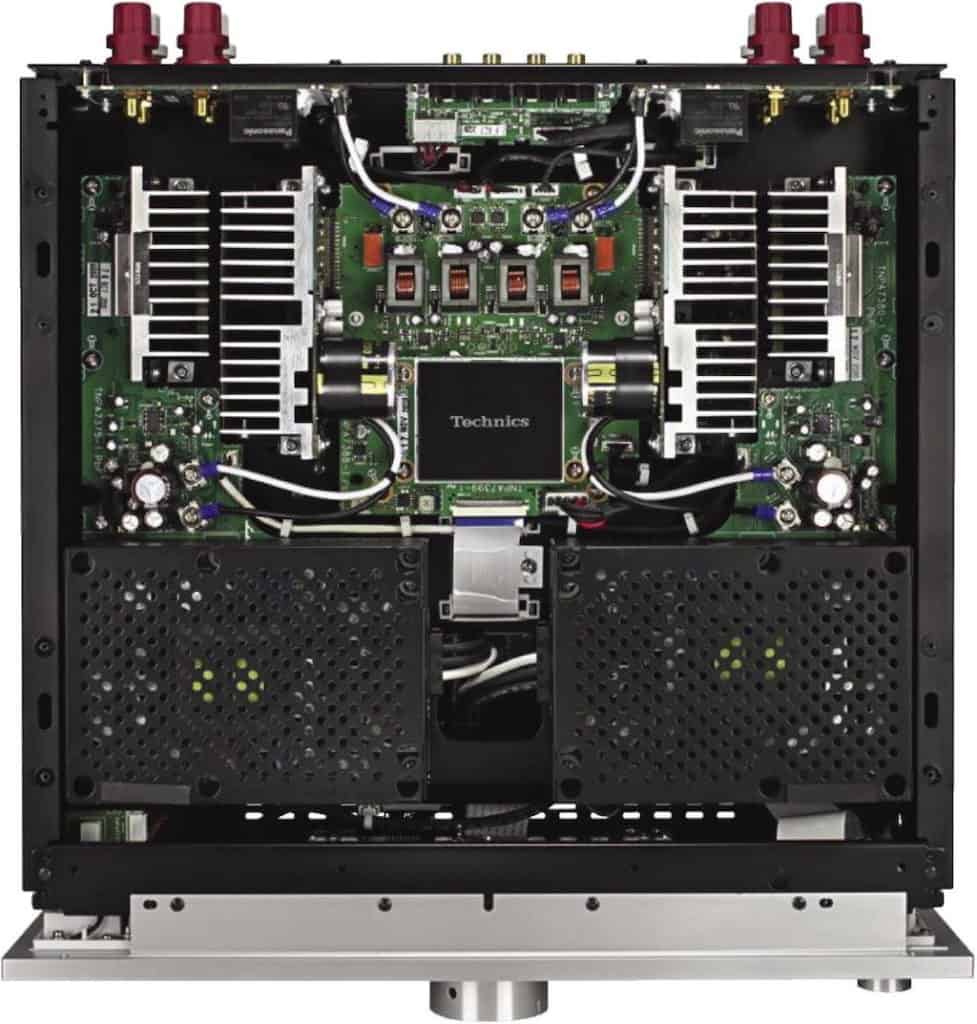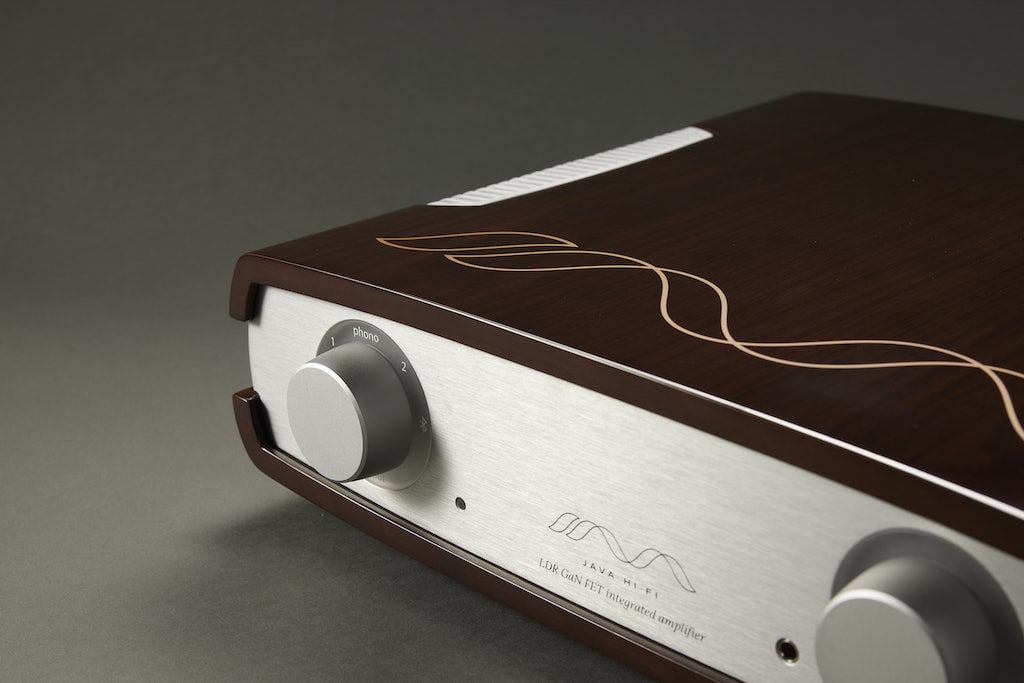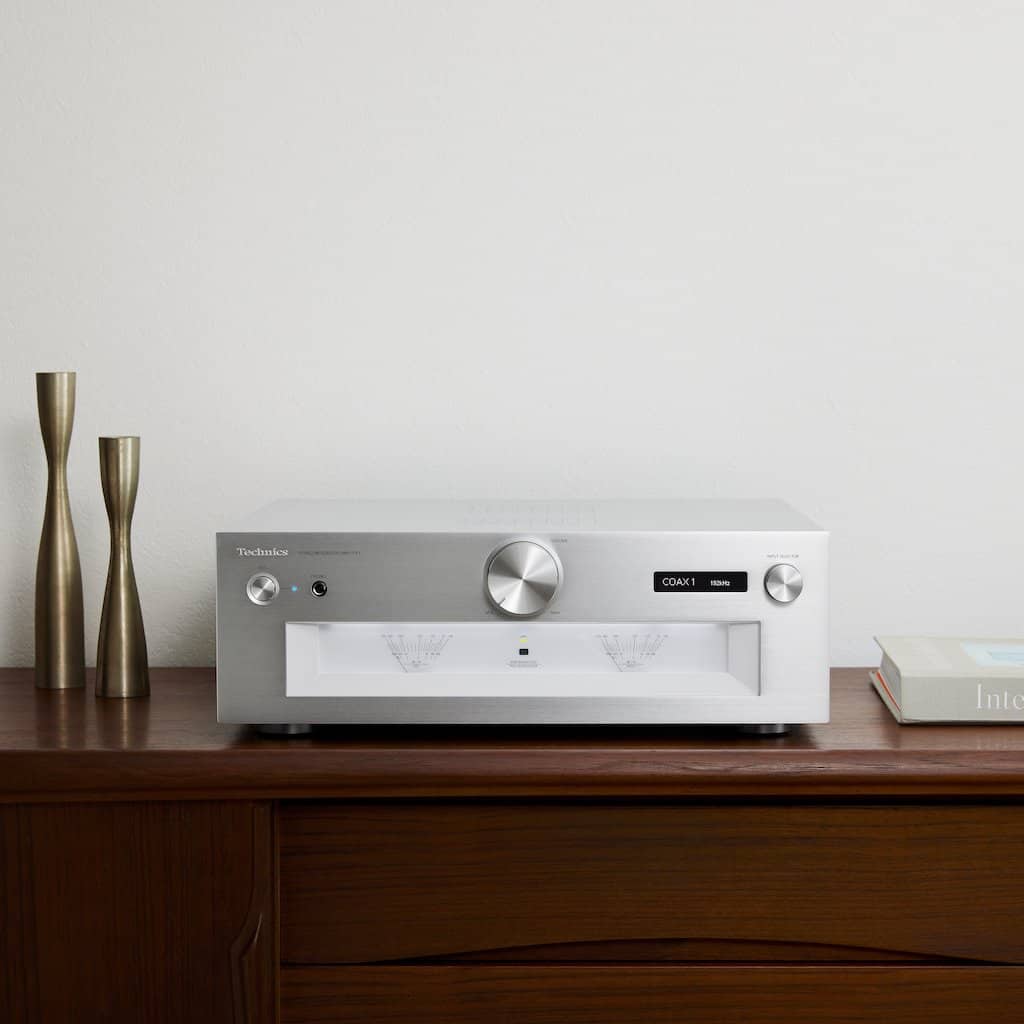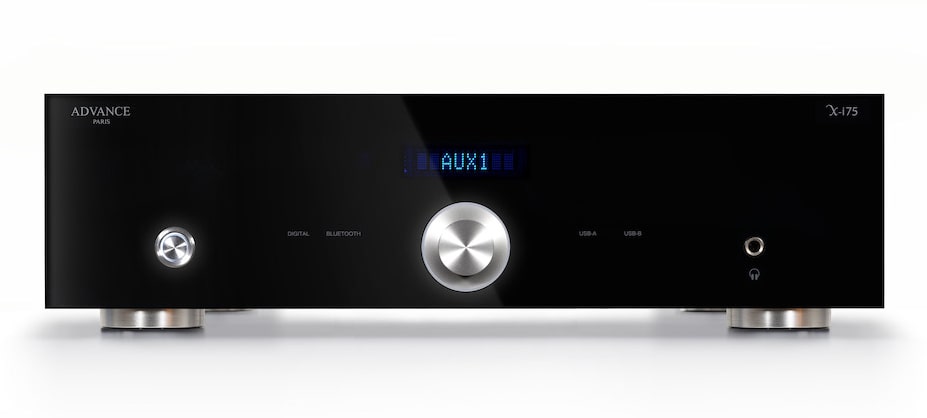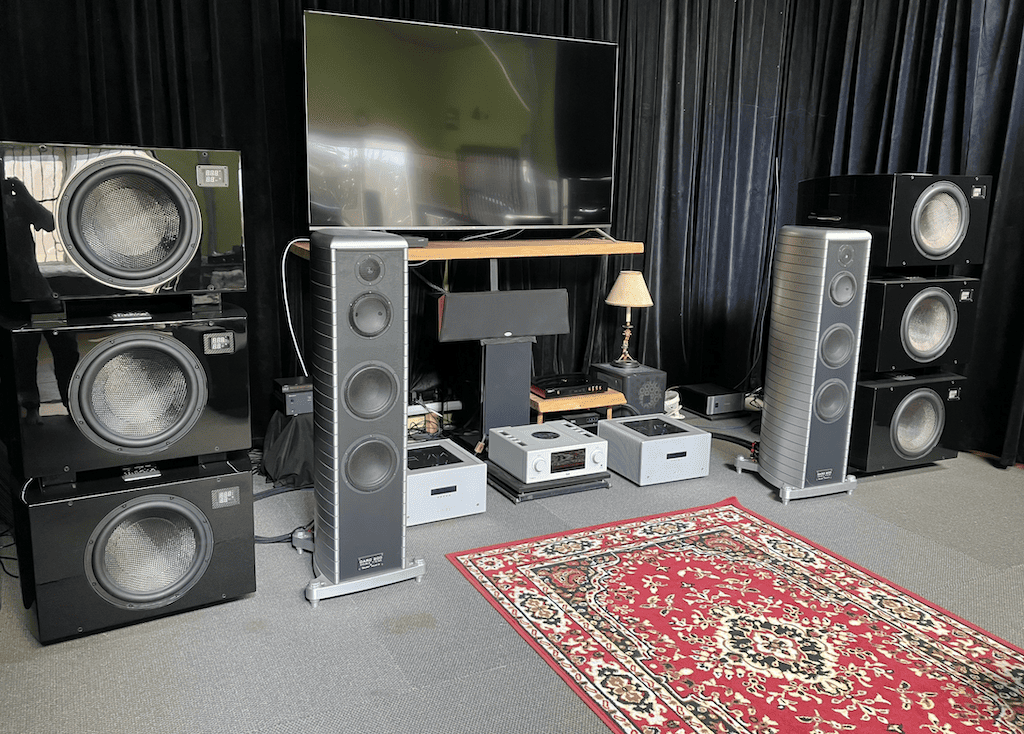Summary
Technics SU-R1000 Integrated Amplifier REVIEW
$13,999
(And introducing the Technics SL-1000R Direct-Drive Turntable @ $31,999)
ANDREW BAKER has his ears massaged by the superb new iteration of the flagship Technics integrated amp (and gets to play with an incredible $32K turntable, too!)
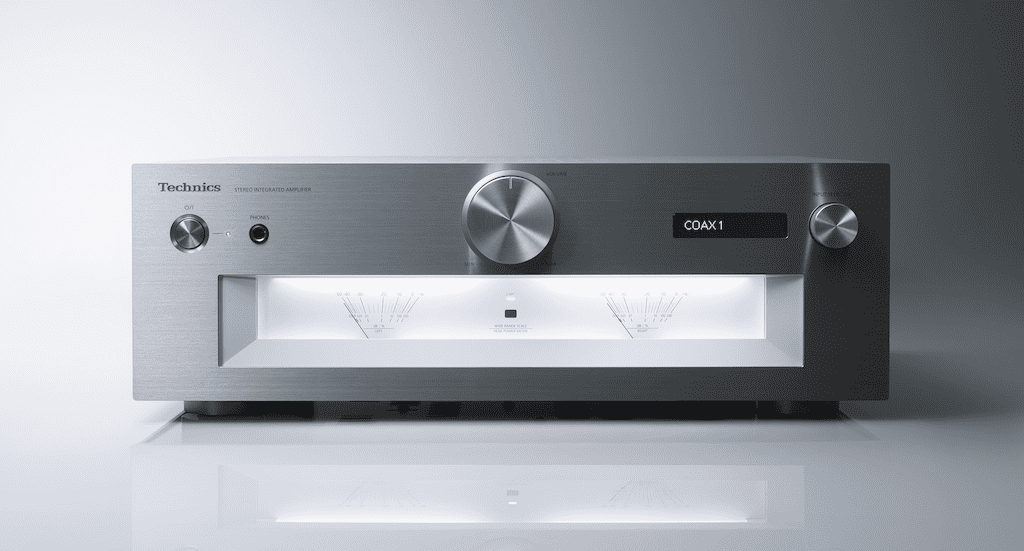
 Back in the ’80s and ’90s, it seemed the cool kids had parents with Technics stereo equipment. Those amps and receivers with the VU meter needles that moved in time with the music and the lit up front panels with big volume knobs just had to mean music would sound better, and it certainly seemed to be the case.
Back in the ’80s and ’90s, it seemed the cool kids had parents with Technics stereo equipment. Those amps and receivers with the VU meter needles that moved in time with the music and the lit up front panels with big volume knobs just had to mean music would sound better, and it certainly seemed to be the case.
Apart from their direct-drive turntables, especially the SL-1200 series, remaining synonymous with DJ equipment (despite originally being intended for the home audio market), Technics kinda fell off my radar in recent years, at least as far as high-end audio goes. It didn’t help of course that Technics was temporarily discontinued in 2010 while owners Panasonic took some time to re-envision the brand.
Would you like to support our mission to bring intelligence, insight and great writing to entertainment journalism? Help to pay for the coffee that keeps our brains working and fingers typing just for you. Witchdoctor, entertainment for grownups. Your one-off (or monthly) $5 or $10 donation will support Witchdoctor.co.nz. and help us keep producing quality content. It’s really easy to donate, just click the ‘Become a supporter’ button below.
In 2016 they returned with the welcome relaunch of the SL-1200 (G) turntable for the hi-fi market. Since then, Technics has been hitting the high-end audio market in force, with a bunch of new, albeit retro-looking amplifiers, turntables, CD players and DACs, in several class levels to suit different budgets.
I had their flagship record player, the SL1000R ($31,999), in the house for a spin, along with the Reference Class SU-R1000 integrated amplifier. And a fine-looking pair they are.
This review is mainly concerned with the amplifier, for reasons we’ll get to soon, but the turntable will be mentioned here and there whenever relevant.
I’ll begin by getting one thing out of the way first: the SU-R1000 is a digital amplifier. But, even having heard it, you may not have guessed that it is digital unless someone told you. More on that a little later.
It may look retro, but internally it is anything but. The SU-R1000 has a built-in DAC with two inputs each for coaxial, optical and USB-B – all you need is a CD player/transport and/or a streaming device or PC. It has a built-in phono stage with a choice of moving coil or moving magnet inputs, and balanced XLR or single-ended RCA. The phono stage can be calibrated, using the supplied Calibration Record, to optimise any particular cartridge with the ability to name and store multiple settings for multiple individual cartridges. There are two further RCA analogue inputs and one XLR. Additionally, there are in/outputs for recording and pre-outs for a subwoofer or using it as a preamplifier. There are binding posts for connecting up to two pairs of speakers.
Not Class D as such (more of a hybrid according to Technics) the SU-R1000 uses Pulse Width Modulation (PWM), essentially turning the analogue input signal into a series of pulses that correspond to the frequency of the input signal. Where, for instance, Class A is at full power all the time, therefore generating heat, Class D switches power on and off as required by the signal. This can of course cause some noise issues, but Technics claim to have solved this problem with the use of a Super Low Noise Regulator which stops noise from mixing in with the high frequencies (hence the hybrid).
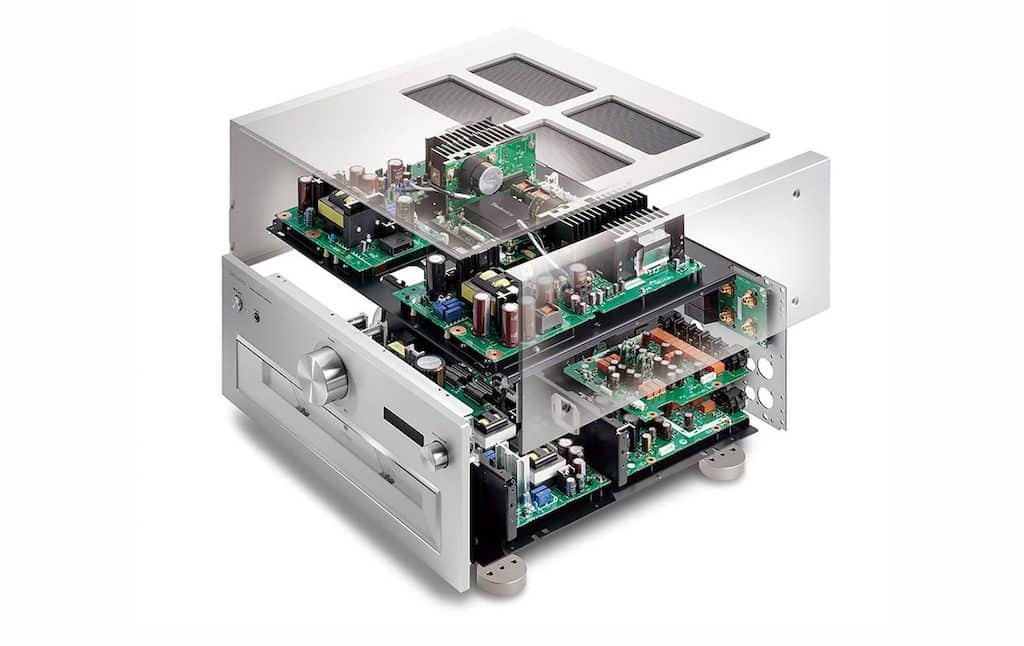 Technics have developed a jitter reduction circuit – which they call the JENO Engine, that is Jitter Elimination and Noise-shaping Optimisation – used in conjunction with the PWM to drastically reduce jitter across the entire frequency range. Another Technics innovation is their Active Distortion Cancelling Technology (ADCT). This acts by determining the differences of output at the speaker terminals and the amp’s JENO output, correcting the digital signal and thus removing any distortion. There are four independent power supply units, one each for the analogue and digital sections in the pre-amp stage and one for each channel. This is designed to suppress power-associated interference throughout the circuits.
Technics have developed a jitter reduction circuit – which they call the JENO Engine, that is Jitter Elimination and Noise-shaping Optimisation – used in conjunction with the PWM to drastically reduce jitter across the entire frequency range. Another Technics innovation is their Active Distortion Cancelling Technology (ADCT). This acts by determining the differences of output at the speaker terminals and the amp’s JENO output, correcting the digital signal and thus removing any distortion. There are four independent power supply units, one each for the analogue and digital sections in the pre-amp stage and one for each channel. This is designed to suppress power-associated interference throughout the circuits.
The phono and analogue sections are a full-discrete circuit design. Again, Technics has developed their own circuit layout, one which prevents interference between the right and left channels with the aim of giving optimal channel separation and noise reduction. According to Technics, “the USB input circuit in the digital input section is equipped with a capacitor of high-quality ruby mica and a power conditioner with nonmagnetic carbon film resistors for blocking electrical noise e.g., from a PC and for minimising the effect of external noise.” The analogue to digital converter uses a high-performance chip made by AKM (Asahi Kasei Microdevices).
The phono stage allows users to adjust the equaliser curve from the standard RIAA to a range of different options: Columbia, Decca, et al. I didn’t play with those settings but it’s a nice touch for those wishing to experiment. The best thing, in my opinion, is the cartridge optimising feature. Using the supplied record and following the easy-to-understand instructions in the user manual, the amp measures and optimises the frequency response of your cartridge as well as terminating crosstalk (that’s where you can get sound bleeding from one channel to the other), while employing a series of test tones. You can then save and name the settings for several individual cartridges.
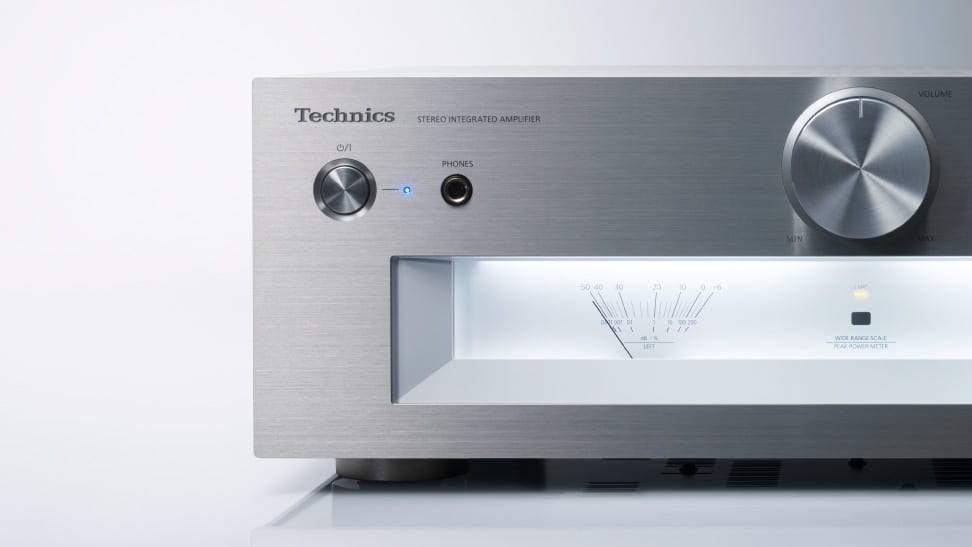 What you have probably by now realised is that this is a digital phono stage. That is, it is converted to digital after the initial analogue signal input. If this is where you angrily stop reading and vow to not bother with this amplifier, then you’d be doing yourself and your records a huge disservice because, my goodness, this thing sounds good.
What you have probably by now realised is that this is a digital phono stage. That is, it is converted to digital after the initial analogue signal input. If this is where you angrily stop reading and vow to not bother with this amplifier, then you’d be doing yourself and your records a huge disservice because, my goodness, this thing sounds good.
Another useful thing the SU-R1000 does, again with the use of test tones and digital processing, is something called Load Adaptive Phase Calibration, or LAPC. This measures and optimises the impedance, gain and phase characteristics of your speakers in relation to the amplifier output and saves it to memory. LAPC can be switched on or off via the rather excellent supplied remote controller, and the difference using my Reference 3A speakers was notable.
The entire chassis of the SU-R1000 is extremely rigid. The internals are laid out across two decks with each circuit isolated and shielded by steel plates. The front fascia is 10mm thick aluminium and the top and sides are 6mm thick. Even the large volume knob, situated top centre, is made from machined aluminium. In addition, the front panel features a power on/off button, 6.3mm headphone jack, LCD display window – small but perfectly visible from across the room – and a rotary input selection knob. Across the bottom is the analogue VU meter window, which can be dimmed in steps or switched off completely.
The SU-R1000 is a mighty amp – measuring 191mm x 430mm x 459mm (h, w, d) and weighing 22.8kg it will certainly fill up most hi-fi racks, but it really does look good. The review unit came in silver but black is also an option. With the use of a gallium nitride (GaN) FET output stage (about which I know almost precisely nothing, despite an apparent wave of enthusiasm surrounding GaN FET technology seemingly due to its high speed and low resistance), the SU-R1000 puts out 150wpc into 8 Ohms. And while it does get warm, it gets to nowhere near the heat of a more conventional Class A amp. The frequency response is stated as 5Hz-80kHz (for digital and line-in) and 20Hz-20kHz for the phono stage. Oh, and there’s a USB input for future firmware upgrades.
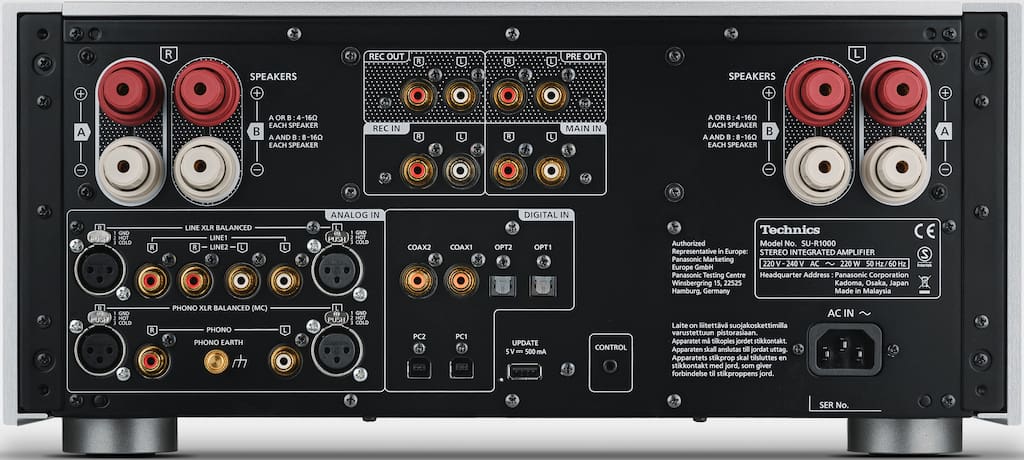 A couple more specs: the input sensitivity and impedance for the phono stage section are MM 2.5mV and 47k Ohms, MC 300mV and 100k Ohms. The headphone amp section is rated at 0.75mW and 32 Ohms and it drove my modest collection of headphones with ease. The DAC accepts all the usual sample rates up to 32bit/384 kHz and has full MQA support for those to whom MQA is considered a worthy pursuit. There is an app for Windows or Apple that can be used to play/control music when plugged into the amplifier. However, I feel an in-built Wi-Fi, ethernet or at least Bluetooth streamer would have been welcome. (Editor note: Technics have instead chosen to include all that in their nifty network players).
A couple more specs: the input sensitivity and impedance for the phono stage section are MM 2.5mV and 47k Ohms, MC 300mV and 100k Ohms. The headphone amp section is rated at 0.75mW and 32 Ohms and it drove my modest collection of headphones with ease. The DAC accepts all the usual sample rates up to 32bit/384 kHz and has full MQA support for those to whom MQA is considered a worthy pursuit. There is an app for Windows or Apple that can be used to play/control music when plugged into the amplifier. However, I feel an in-built Wi-Fi, ethernet or at least Bluetooth streamer would have been welcome. (Editor note: Technics have instead chosen to include all that in their nifty network players).
I couldn’t get my Raspberry Pi streamer (using RopieeeXL as a Roon Bridge and for Spotify Connect) to work when directly connected to the onboard DAC. I used a spare laptop with Roon installed plugged directly via USB and while I could play manually from Roon (streaming Tidal and local files) for some reason my Roon Core couldn’t – or wouldn’t – find the Technics DAC remotely. [Addendum: This may have been a fault of my computer, as not long after writing this review, it died completely. When adding Roon Core to another computer, I noticed the Technics DAC was now in the list of possible audio devices to enable, where it hadn’t been before. Unfortunately, I no longer had the amplifier to test it out.]
(If you just want to read about the amplifier then feel free to skip the next few paragraphs.)
Because I had both Technics components together, and not feeling I could justify a separate and fair review due to not having similarly priced equipment on hand, I thought I’d include it here and mention it throughout whenever relevant. Besides, what vinyl lover in their right mind would turn down the opportunity to have such a high-end turntable in their system, even for a limited time?
At 32 grand, the SL-1000R is Technics’ flagship record player and what an incredible feat of engineering it is. It is absolutely a luxury item. The plinth, or cabinet, is comprised of three layers consisting of aluminium (30mm at its thickest), aluminium die-cast and bulk moulding compound (BMC), sitting on silicon-rubber adjustable feet reinforced with tubes made from microcell polymer. The platter is three layers – the top being 10mm thick brass, fitted with 12 tungsten weights around the perimeter to aid speed stability. This is laminated onto the die-cast aluminium middle layer which sits on a rubber vibration deadening mat on the bottom. The platter alone weighs almost 8kg. A rubber platter mat, on which the record sits, is supplied. The direct-drive motor is based on that found in the SL-1200G (2016) but with significant improvements. I’ll let you read up on it further, but it’s a coreless double coil twin-rotor type, optimized to remove all vibrations and noise. The SL-1000R weighs an incredible 40kg or so.
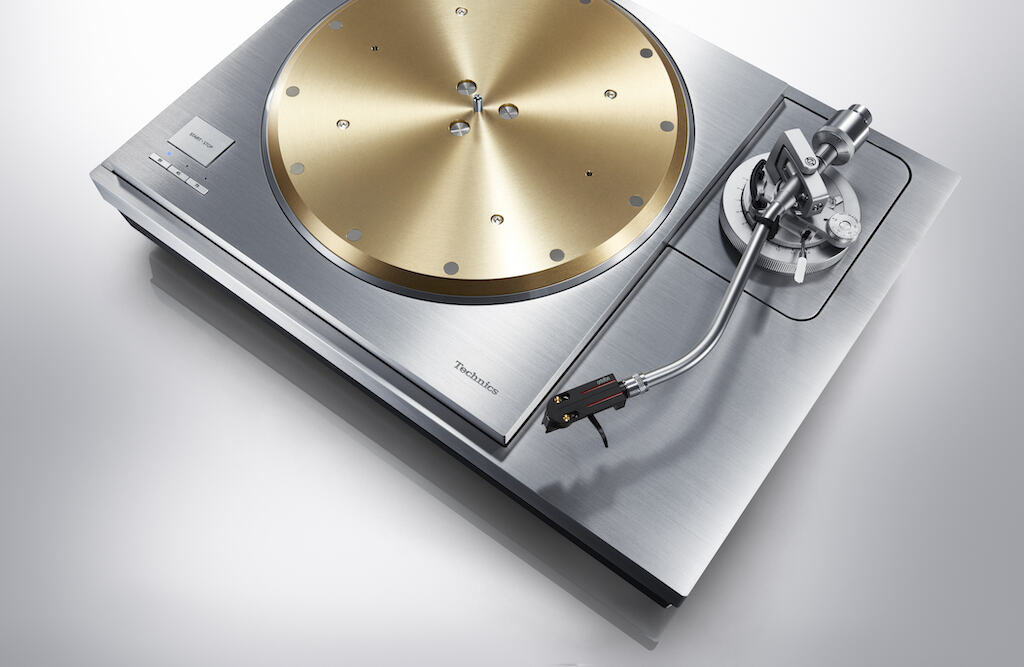 Every effort has been made to completely eliminate unwanted noise and vibration.
Every effort has been made to completely eliminate unwanted noise and vibration.
The tonearm (which comes sans headshell – I was supplied an Ortofon LH-9000) is an S-shaped design – effectively 10” in length – made from lightweight, high damping magnesium and utilising ruby bearings, and is assembled and adjusted by “highly skilled Japanese craftsmen”. The tonearm base is integrated into the plinth in such a way as to, you guessed it, prevent vibration making its way to the needle and negatively affecting the sound. One or two more arm bases can be added at any stage.
A DIN cable connects the turntable to the outboard power control unit. The control unit, housed in matching silver aluminium, uses a switching power supply to maintain the correct torque for driving that heavy platter with an “unwanted noise reduction circuit” to prevent voltage supply noise making its way to the stylus.
Setting up the SL-1000R is really just as easy as any turntable and the User Manual provides a pretty simple to follow guide. That being said, at this price, I’m sure your salesperson would happily come to your home and do the set-up if you wished. I used my EMT TSD-15n moving coil but the possibilities at the price point of this turntable are limitless.
Operating the turntable is just wonderful. The Start/Stop button barely needs pressing and the platter immediately spins to life and then stops immediately when pressed again. You can spin 33, 45 or 78 rpm records, with the control unit allowing minute speed adjustments if necessary – it also uses a digital system to detect speed variations. Rest assured you will get precision speed stability. The arm lift and tonearm operation are deliciously smooth, adding further elegance to the ritual of lowering the needle on a record. The SL-1000R exudes an oily industrial scent reminiscent of brand-new Leben amplifiers, particularly noticeable when you remove the supplied Perspex dust cover (also beautifully made) before a listening session.
Besides the flash of brass on the platter, the SL-1000R is not particularly blingy looking for the money but rather has an almost understated beauty.
For listening, along with using all the built-in features of the Technics amp, I used my Electrocompaniet ECD 2 DAC, RopieeeXL streamer, Cambridge Audio Azure CD player (as a transport), EAR 834P tube phono stage, A23 SUT and my Lenco/Apparition12/Hana/EMT analogue combo. I also used the aforementioned SL-1000R Turntable, fitted with my EMT TSD15n cartridge. The main speakers used were my Reference 3A floorstanders and I had on hand a Perreaux 200iX integrated amplifier and a Unison Research Unico SE hybrid integrated for comparison. My room is approximately 12 ft (from the wall behind the speakers to the wall behind the listening position) by 10 ft wide. The room is actually wider, but I’ve created a faux wall with the use of a 4×4 Ikea Kallax unit filled with vinyl. Furnishing, draperies, carpet, books and records successfully help to “treat” the almost 8 ft high listening area.
Before settling in for the first of many listening sessions, the first thing I did was run the LAPC and phono calibration set-up processes. This was super easy and relatively quick. The good thing is that both can be turned off, making for easy comparisons.
With LAPC off, the sound was excellent, like any decent, if ordinary, amplifier but switching it on I felt that besides a bit more openness, the Technics was giving me that little bit more from my speakers in terms of bass control, treble extension and detail. Far from being merely a gimmick, it sounded totally natural, just as though my speakers had been woken up a bit more. I left LAPC on for the duration of the review period and I also left the tone settings in direct mode. I didn’t once feel the need to add more bass, adjust the treble, et cetera, but it’s nice to know it’s there if needed.
It didn’t take too long to realise this Technics amplifier is something special. It was at once elegant and authoritative, nuanced and dynamic. The thought ‘Oh this sounds good for a digital amplifier’ didn’t even enter my head. Yes, it has a super clean and clear sound but rather than coming across as clinical and dull, it remains perfectly rich and natural at all times. Tonally, I noticed a touch of warmth which, along with a high level of precision and scale added to the listening pleasure.
The following music selections were listened to both on vinyl and via Roon or CD many times over.
Black Sabbath’s album Paranoid (1970, Warner Bros) can be exhilarating or terrifying, depending on how a particular system/component handles it. The Technics managed the former, having complete control over the speakers and delivering a breath-taking performance of ‘War Pigs’. The drumming, where most of the potential anxiety lies, had pure dynamic impact, energising the room without overpowering it. I could easily distinguish and home in on each component of the drumkit: there’s the snare, there’s the tom, the crash cymbal, the ride. And I could make out an extra metallic jangling which I had not noticed before, maybe a tambourine bar attached to the hi-hat or perhaps Ozzy himself subtly rattling a tambourine just off-mic.
Playing this track with the SL-1000R turntable isolated this even further, to a surprising and almost ghostly extent. And overall, it displayed as much composure and control over the record as the amp did the speakers. It delivered powerful tight and textured bass while revealing the smallest of details. Speaking of Ozzy, when he sang, I noticed an uncanny kind of space or atmosphere around him, whether it was the result of a booth he was singing from or a side room I couldn’t tell, but it helped enforce the life-like quality and nuance I was hearing. Bass notes also had excellent distinction and there were low notes that perhaps before were cancelled out by the kickdrum but through the Technics amp were clear from the mix. Image separation was excellent and though the soundstage was not quite as wide as the Unison Research amplifier, this didn’t detract from the performance of the SU-R1000 one bit. As I inched the volume ever louder, the song became more impactful and exciting but importantly, the Technics managed to maintain absolute control and clarity.
The Perreaux 200iX, priced just a couple thousand less than the Technics, has a slightly more prominent bass character; that is, it’s deeper and punchier. The soundstage is noticeably wider and it is a touch more holographic but the Technics excels at transparency and attack and has a more grand and elegant nature; refined but by no means boring. The SL-1000R lit the track up beyond what I’d experienced previously, adding more dimension and depth to the instruments and vocals, emphasising dynamics and micro details. Attack and transients were breathtaking.
While my EAR 834P sounded superb with the Technics (amp and turntable) the optimised onboard phono stage captivated me enough that I kept it employed full time. The EAR perhaps is a little more mid-range focused and has an expansive coloured sound signature whereas the Technics is exceptionally clean and crisp, having an open sparkly treble and high levels of detail and dynamics with strong articulate bass. Purists might ask, how could you choose a digital amp over tubes, or even traditional solid-state for that matter, but that’s how it is folks. Technics poured a large quantity of money into this phono stage, these are the results and I like it – quite possibly more so than the EAR/A23 combo.
Regarding the DAC section, I found I preferred my Electrocompaniet just slightly over the Technics, though in reality there wasn’t much in it. The latter was a touch recessed and lacking just the last degree in terms of the sort of textural aspects of the sound in comparison. Yet it is an outstanding DAC and I would easily live with it alone, without feeling the immediate need for separates especially if I’m on a tight budget. Perhaps it was more a case of difference and preference rather than one being better than the other. If I ever buy myself an SU-R1000, I’d seriously consider assigning the Electrocompaniet to another system.
Listening to Esther Phillips’ stunning blues/soul album Black-Eyed Blues (1973, KUDU Records, engineered by one Rudy Van Gelder), I felt as though I was sitting up front in some intimate venue with well-executed acoustics. The timbres and rhythmic drive of the band – electric guitar, bass, drums and organ – earned my full attention. The clean tone of the guitar, with or without reverb, the beautifully timed cymbal work of the drummer and the driving contrast between organ and bass was captivating. Esther Phillips’ voice, expressive and emotionally charged, really stood out with such nuance and life that the intimate feeling of her seemingly singing directly to me (okay, technically she was, for I was, after all, alone in my room) was enhanced. With the Technics’ uncanny ability to recreate space and dimension, I could really appreciate the individual performers while simultaneously marvelling at how together they created this wonderful animated musical entity.
I think I’ve been harping on about Bill Callahan’s Gold Record (2020, Drag City) since its release, but for good reason. It’s beautifully recorded and has not one dull song. Through the Technics, Callahan’s voice was starkly present, deep and resonant and guitar strings, plucked or strummed, had delicacy and nuance along with space, scale and sheer presence. The SL-1000R turntable accentuated this with a casual flourish, outlining and highlighting images in high definition and pulling out the subtlest details to the fore.
On Golden Smog’s Weird Tales (1998, Rykodisc/Rhino) there’s a beautiful little track called ‘Please Tell My Brother’, a solo number with Jeff Tweedy singing and playing acoustic guitar. This song is lovely on any system but played on the SL-1000R turntable through the SU-R1000 amp, it was something else again. The feeling of being in the presence of the singer was so real, I had to replay the track several times to relive the experience (the problem with the song being its brevity). It seemed Tweedy was illuminated from behind somehow, propelling him out into reality. The sound of the guitar was rich and realistic almost beyond belief – and I have several real-life guitars on hand to compare. Ordinarily, you can hear Tweedy strumming gently and along with the melody, there is the sound of the plectrum striking the strings. With this Technics combination, this sound was so pronounced and prominent I couldn’t help but shake my head in admiration. It was so isolated and yet clearly part of the playing, as to become almost like a third instrument – a sort of percussion if you will – or at least a third layer of the song. Almost indescribably good. This effect was there when switching to the Perreaux amplifier, though it wasn’t quite as pronounced.
Electronic music features heavily in my day-to-day playlists – EDM, IDM, minimal techno, et al – and the Technics revelled in all I served it. Clean and crisp with breathtaking layering and tuneful, punchy bass, wonderful dynamics and micro-details. It was easy to imagine being in some small dark venue, looking up at the artist behind their laptops and synths. My small venue was certainly filled with a dazzling array of electronic bleeps and tweets and it became extremely addictive. The great thing about Roon is that it just keeps on playing music, so I have a constant flow of similar-genre music, making new discoveries along the way.
Plug a set of headphones into the socket on the front panel and the speakers are automatically bypassed. LAPC is also turned off – try to turn it on and you are told to disconnect the headphones.
At my desktop, I use a Drop+ THX AAA 789 headphone amp (yes, that really is its name) and in my living room, I have a Woo Audio WA6 OTL tube headphone amp, paired with an MHDT Labs Stockholm DAC. Trying a range of headphones in the Technics – Sennheiser, Beyerdynamic, HiFiMan, AKG – I was surprised to find the sound was closer to the Woo Audio amp than to the notoriously neutral (and somewhat divisive) AAA 789. There was the clean clarity of the latter but with the slightly warm coloured tone and spaciousness the Woo provides. There was good layering, coming from well behind my head, and excellent bass extension. Treble detail was good but the midrange really shone through, especially with vocals and imaging. My Sennheiser HD660S headphones (also divisive within the head-fi community) seemed to pair especially well. I was half expecting the headphone section of the SU-R1000 to be just alright but it is in fact excellent, clearly the result of the same level of engineering that has gone into every other stage of this amplifier.
The SU-R1000 is an exquisite amplifier – future-fi at its most exciting. It is up there with some of the finest amps I have heard to date.
Sure, it has a large footprint, but you only need a streaming device, turntable and speakers – no separate DAC or phono stage necessary. In fact, the only major fault I can think of is that at the price, this doesn’t have an onboard streamer – not even Bluetooth like the 200iX. While that might further boost its versatility, given everything that is already cleverly packed into the SU-1000R chassis, one risks coming across as somewhat greedy or entitled in making such a complaint, though I stubbornly think it would be a good idea. (Editor note: Technics has, like some other manufacturers, decided to include these things in their network players instead).
Performance-wise, this Technics amp has excellent image resolution, and it is dynamic and punchy with excellent detail and timbre reproduction and transparency. What’s more, it does all this while maintaining an air of serious elegance. Plus, who doesn’t love an analogue VU meter?
Other amps might go deeper and harder with bass, but with the Technics level of detail and insight, I wasn’t the least bit concerned.
Despite the rather large difference in price between the amp and turntable, they worked very well together. Of course, the SL-1000R turntable has to be heard in a similarly sky-high system to fully appreciate its glorious capabilities, but its unbelievable talents were patently obvious even in a modest system.
As to the Technics Reference Class SU-R1000 integrated amplifier: “Reference” indeed.

